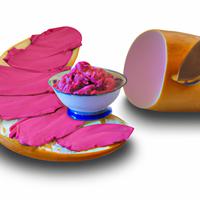
1 serving (100 grams) contains 250 calories, 6.0 grams of protein, 8.0 grams of fat, and 40.0 grams of carbohydrates.

Log this food in SnapCalorie

Nutrition Information
Calories |
595.2 | ||
|---|---|---|---|
% Daily Value* |
|||
| Total Fat | 19.0 g | 24% | |
| Saturated Fat | 4.8 g | 24% | |
| Polyunsaturated Fat | 0 g | ||
| Cholesterol | 11.9 mg | 3% | |
| Sodium | 714.3 mg | 31% | |
| Total Carbohydrates | 95.2 g | 34% | |
| Dietary Fiber | 4.8 g | 17% | |
| Sugars | 23.8 g | ||
| protein | 14.3 g | 28% | |
| Vitamin D | 0 mcg | 0% | |
| Calcium | 119.0 mg | 9% | |
| Iron | 4.8 mg | 26% | |
| Potassium | 238.1 mg | 5% | |
* Percent Daily Values are based on a 2,000 calorie diet. Your daily values may be higher or lower depending on your calorie needs.
Food Attributes
Source of Calories
About Bread with pink spread
Bread with pink spread is a simple yet intriguing snack or breakfast option, often associated with a playful or dessert-like appeal. The pink spread is typically made by blending cream cheese or whipped cream with a sweet ingredient like strawberry, raspberry, or beet puree, which gives it its distinct color. Some variations may use food coloring for aesthetic purposes. Originating in Western cuisine, it has gained popularity in modern fusion dishes for its visual appeal and versatility. Nutritionally, its health benefits depend on the ingredients used—fresh fruit-based spreads can offer vitamins and antioxidants, while versions with processed sugars or food dyes may be less beneficial. Paired with whole-grain bread, this treat can provide fiber and a modest protein boost. However, moderation is key, as pink spreads can be high in sugar and fats, making it an occasional indulgence rather than a daily staple.



